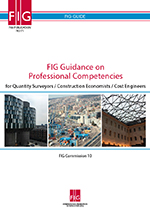FIG PUBLICATION NO. 71
FIG Guidance on Professional Competencies for Quantity
Surveyors / Construction Economists / Cost Engineers
FIG Commission 10
FIG GUIDE
Author: SeeLian Ong, Chair of FIG Commission 10
2015-2018
FOREWORD
The construction industry remains one of the most important engine of
growth in both the developed and developing economies. Over the next 7 years
the global construction industry will grow from USD 7.2 trillion to over USD
12 trillion.
Construction industry in developing or emerging economies is set to
increase by 110% and infrastructure construction by 128%. With this rapid
growth the global construction industry presents many opportunities but also
has a number of challenges.
The role of Quantity Surveyors, or Cost Engineers or Construction
Economists is becoming important to ensure that the project cost are
measured and monitored professionally to ensure value for money for the
stakeholders.
It is with this in mind that Commission 10 of FIG has developed and
publish a this Guidance for Professional Competencies for Quantity Surveyors
/ Cost Engineers / Construction Economists. It is the object of this
Guidance to help us to train these professionals so that they have the right
competencies to undertake the tasks given to them. The Guidance can also be
used by institutions of higher learning to develop programme or courses at
both undergraduate and post-graduate levels.
I wish to congratulate Commission 10 for this initiative and I hope you
will find this Guidance helpful in your area of work.
Chryssy Potsiou FIG President
(2015-2018)
MESSAGE BY THE CHAIR OF COMMISSION 10
The professionals involved in the measurement and management of
construction costs are called by different names in different countries. In
the UK and most Commonwealth countries they are called Quantity Surveyors
(QS), whilst those in Continental Europe they are called Construction
Economists (CE) and in Northern America they are called Cost Engineers
(CEgr).
QS/CE/CEgr are the cost managers of construction. They are initially
involved with the capital expenditure phase of a building or facility, which
is the feasibility, design and construction phases, but they can also be
involved with the extension, refurbishment, maintenance and demolition of a
facility. QS/CE/ CEgr work in all sectors of the construction industry
worldwide such as buildings, infrastructure as well as process engineering
plants. They must understand all aspects of construction over the whole life
of a building or facility. They must have the ability to manage cost
effectively, equating quality and value with individual client needs.
As construction industry is now a global industry it is important that
professionals in the industry working across the globe should have a
consistent standard of competencies which in turn provide confidence to
their employers or clients.
Dr. See-Lian Ong Chair, Commission 10 (2015-2018)
ABOUT THE COMPETENCIES
This Guide aims to assist in the assessment of the competencies of
QS/CE/CEgr. These competencies are not just a list of tasks or functions,
they are also based upon attitudes and behaviours.
The competencies have been drawn up in a generic way so that they can be
applied to different areas of practice and geographical locations. This
Guide is designed to help you interpret these competencies within the
context of construction industry in your chosen area of work.
The competencies are defined at three levels of attainment and the
candidate must achieve specific combination of competencies at the
appropriate level. The candidate must reach the required level in a logical
progression and in successive stages:
- Level 1 – knowledge and understanding
- Level 2 – application of knowledge and understanding
- Level 3 – reasoned advice and depth of technical knowledge
The competencies are in three distinct categories:
- Mandatory competencies – the personal,
interpersonal, professional practice and business competencies; and
- Core competencies – the primary competencies of
your chosen scope or area of training.
- Optional competencies – a set of competencies
selected by the candidate from a list defined for the particular scope
or area of training. In most cases there is an element of choice. These
are mostly technical competencies, but certain mandatory competencies
also appear on the optional competency list and candidates are permitted
to select one of these at a higher level.
HOW TO USE THIS GUIDE
This Guide is designed to help the candidate to understand more about
qualifying as a QS/CE/CEgr. It is appreciated that markets may vary from
country to country. If you have any queries please contact your local
surveying institutions. This guidance includes supplemental guidance which
is set out in three sections.
- Section one – Profile of newly qualified QS/CE/CEgr.
- Section two – Selecting optional competencies.
- Section three – Study check list. NOTE: In the case of doubt the
competency definitions in this Guide will always take priority.
Read the full FIG Publication 71 in pdf
Author: SeeLian Ong
Copyright © The International Federation of Surveyors (FIG),
May 2018.
All rights reserved.
International Federation of Surveyors (FIG)
Kalvebod Brygge 31–33
DK-1780 Copenhagen V
DENMARK
Tel. + 45 38 86 10 81
E-mail: FIG@FIG.net
www.fig.net
Published in English
Copenhagen, Denmark
ISSN 1018-6530 (printed)
ISSN 2311-8423 (pdf)
ISBN 978-87-92853-76-9 (printed)
ISBN 978-87-92853-77-6 (pdf)
Published by
International Federation of Surveyors (FIG)
Layout: Lagarto
|

























